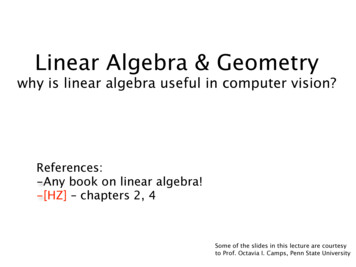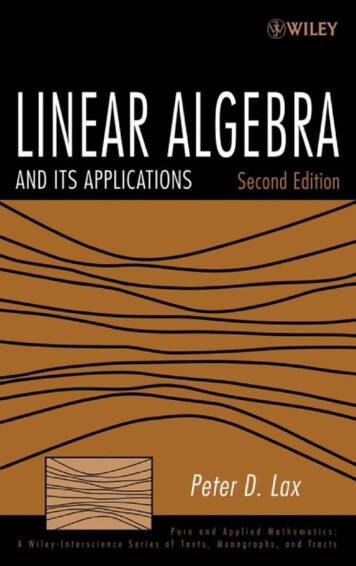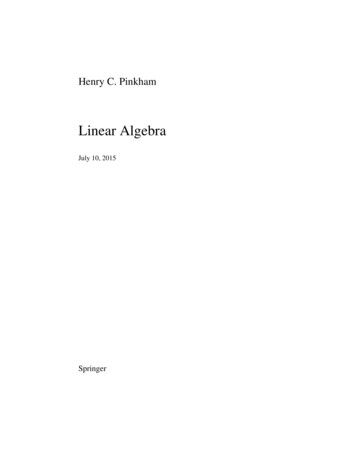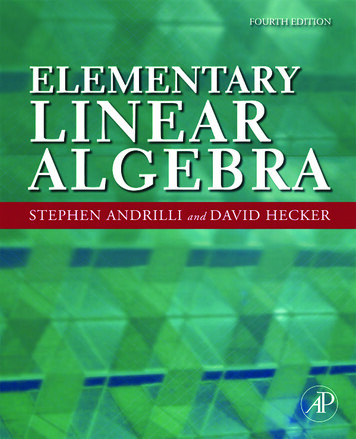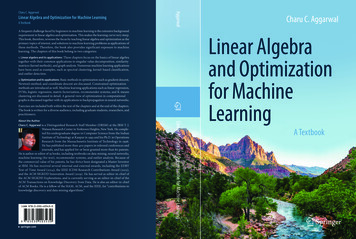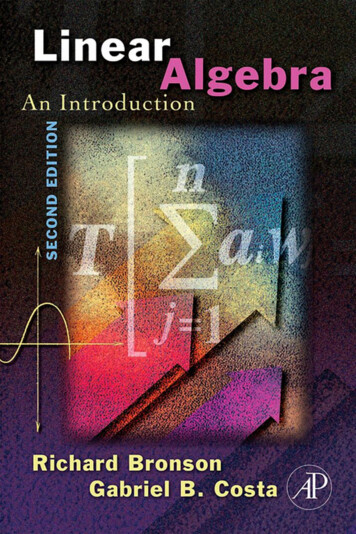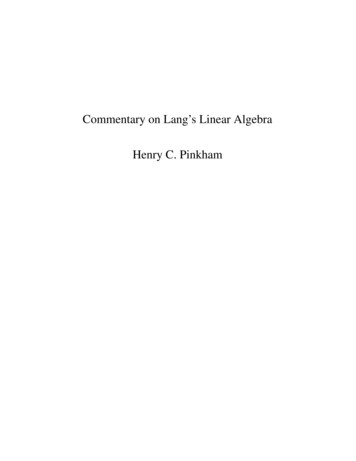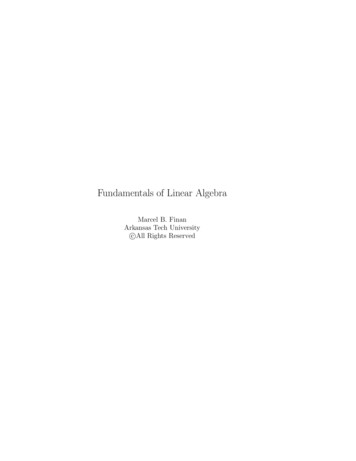
Transcription
Continue
Linear algebra and its applications 4th edition solutions pdf downloadWant more? Advanced embedding details, examples, and help! This expansive textbook survival guide covers the following chapters: 8. The full step-by-step solution to problem in Linear Algebra and Its Applications, were answered by , our top Calculus solution expert on 01/19/18, 04:43PM. Since problems from 8 chapters in Linear Algebra and ItsApplications, have been answered, more than 56074 students have viewed full step-by-step answer. Linear Algebra and Its Applications, was written by and is associated to the ISBN: 9780030105678. This textbook survival guide was created for the textbook: Linear Algebra and Its Applications,, edition: 4. Addition principle of probability. P(A or B) P(A) P(B) - P(A and B). If A and B are mutually exclusive events, then P(A or B) P(A) P(B) Common logarithm A logarithm with base 10. Complex plane A coordinate plane used to represent the complex numbers. The x-axis of the complex plane is called the real axis and the y-axis is the imaginary axis Constant function (on an interval) ƒ(x 1) ƒ(x2) x for any x1 and x2 (in the interval) Convenience sample A sample that sacrifices randomness for convenience Cycloid The graph of the parametric equations Derivative of ƒ at x a ƒ'(a) lim x:a ƒ(x) - ƒ(a) x - a provided the limit exists Graph of an inequality in x and y The set of all points in the coordinate plane corresponding to the solutions x, y ofthe inequality. Initial side of an angle See Angle. Negative association A relationship between two variables in which higher values of one variable are generally associated with lower values of the other variable. Numerical model A model determined by analyzing numbers or data in order to gain insight into a phenomenon, p. 64. Objective functionSee Linear programming problem. Opens upward or downward A parabola y ax 2 bx c opens upward if a 0 and opens downward if a 0. Pascal’s triangle A number pattern in which row n (beginning with n 02) consists of the coefficients of the expanded form of (a b)n. Real part of a complex number See Complex number. Standard form:equation of a circle (x - h)2 (y - k2) r 2 Subtraction a - b a (-b) Unit vector in the direction of a vector A unit vector that has the same direction as the given vector. Zero factorial See n factorial. Zero matrix A matrix consisting entirely of zeros. Published on Feb 19, 2019Full download : Linear Algebra And Its Applications 4th Edition LaySolutions Manual, Linear Algebra And Its Applications,Lay,So. WalshFollow this publisher - current follower count:1 Comments Discussions Members Linear Algebra (David C. Lay- 4th edition) Solutions manual 1 member likes this File loading please wait. F O U R T H E D I T I O N Linear Algebra and Its Applications David C. Lay University ofMaryland—College Park Addison-Wesley Editor-in-Chief: Deirdre Lynch Senior Acquisitions Editor: William Hoffmann Sponsoring Editor: Caroline Celano Senior Content Editor: Chere Bemelmans Editorial Assistant: Brandon Rawnsley Senior Managing Editor: Karen Wernholm Associate Managing Editor: Tamela Ambush Digital Assets Manager:Marianne Groth Supplements Production Coordinator: Kerri McQueen Senior Media Producer: Carl Cottrell QA Manager, Assessment Content: Marty Wright Executive Marketing Manager: Jeff Weidenaar Marketing Assistant: Kendra Bassi Senior Author Support/Technology Specialist: Joe Vetere Rights and Permissions Advisor: Michael Joyce ImageManager: Rachel Youdelman Senior Manufacturing Buyer: Carol Melville Senior Media Buyer: Ginny Michaud Design Manager: Andrea Nix Senior Designer: Beth Paquin Text Design: Andrea Nix Production Coordination: Tamela Ambush Composition: Dennis Kletzing Illustrations: Scientific Illustrators Cover Design: Nancy Goulet, Studiowink CoverImage: Shoula/Stone/Getty Images For permission to use copyrighted material, grateful acknowledgment is made to the copyright holders on page P1, which is hereby made part of this copyright page. Many of the designations used by manufacturers and sellers to distinguish their products are claimed as trademarks. Where those designationsappear in this book, and Pearson Education was aware of a trademark claim, the designations have been printed in initial caps or all caps. Library of Congress Cataloging-in-Publication Data Lay, David C. Linear algebra and its applications / David C. Lay. – 4th ed. update. p. cm. Includes index. ISBN-13: 978-0-321-38517-8 ISBN-10: 0-321-38517-9 1.Algebras, Linear–Textbooks. I. Title. QA184.2.L39 2012 5120 .5–dc22 2010048460 Copyright 2012, 2006, 1997, 1994 Pearson Education, Inc. All rights reserved. No part of this publication may be reproduced, stored in a retrieval system, or transmitted, in any form or by any means, electronic, mechanical, photocopying, recording, or otherwise,without the prior written permission of the publisher. Printed in the United States of America. For information on obtaining permission for use of material in this work, please submit a written request to Pearson Education, Inc., Rights and Contracts Department, 501 Boylston Street, Suite 900, Boston, MA 02116, fax your request to 617-671-3447, ore-mail at . 1 2 3 4 5 6 7 8 9 10—DOW—14 13 12 11 10 ISBN 13: 978-0-321-38517-8 ISBN 10: 0-321-38517-9 To my wife, Lillian, and our children, Christina, Deborah, and Melissa, whose support, encouragement, and faithful prayers made this book possible. About the Author David C. Lay holds a B.A. from Aurora University (Illinois), and an M.A. andPh.D. from the University of California at Los Angeles. Lay has been an educator and research mathematician since 1966, mostly at the University of Maryland, College Park. He has also served as a visiting professor at the University of Amsterdam, the Free University in Amsterdam, and the University of Kaiserslautern, Germany. He has publishedmore than 30 research articles on functional analysis and linear algebra. As a founding member of the NSF-sponsored Linear Algebra Curriculum Study Group, Lay has been a leader in the current movement to modernize the linear algebra curriculum. Lay is also a co-author of several mathematics texts, including Introduction to Functional Analysiswith Angus E. Taylor, Calculus and Its Applications, with L. J. Goldstein and D. I. Schneider, and Linear Algebra Gems—Assets for Undergraduate Mathematics, with D. Carlson, C. R. Johnson, and A. D. Porter. Professor Lay has received four university awards for teaching excellence, including, in 1996, the title of Distinguished Scholar–Teacher of theUniversity of Maryland. In 1994, he was given one of the Mathematical Association of America’s Awards for Distinguished College or University Teaching of Mathematics. He has been elected by the university students to membership in Alpha Lambda Delta National Scholastic Honor Society and Golden Key National Honor Society. In 1989, AuroraUniversity conferred on him the Outstanding Alumnus award. Lay is a member of the American Mathematical Society, the Canadian Mathematical Society, the International Linear Algebra Society, the Mathematical Association of America, Sigma Xi, and the Society for Industrial and Applied Mathematics. Since 1992, he has served several terms onthe national board of the Association of Christians in the Mathematical Sciences. iv Contents Preface ix A Note to Students xv Chapter 1 Linear Equations in Linear Algebra 1 INTRODUCTORY EXAMPLE: Linear Models in Economics and Engineering 1.1 Systems of Linear Equations 2 1.2 Row Reduction and Echelon Forms 12 1.3 Vector Equations 241.4 The Matrix Equation Ax D b 34 1.5 Solution Sets of Linear Systems 43 1.6 Applications of Linear Systems 49 1.7 Linear Independence 55 1.8 Introduction to Linear Transformations 62 1.9 The Matrix of a Linear Transformation 70 1.10 Linear Models in Business, Science, and Engineering 80 Supplementary Exercises 88 Chapter 2 Matrix Algebra91 INTRODUCTORY EXAMPLE: Computer Models in Aircraft Design 2.1 Matrix Operations 92 2.2 The Inverse of a Matrix 102 2.3 Characterizations of Invertible Matrices 111 2.4 Partitioned Matrices 117 2.5 Matrix Factorizations 123 2.6 The Leontief Input–Output Model 132 2.7 Applications to Computer Graphics 138 2.8 Subspaces of Rn 146 2.9Dimension and Rank 153 Supplementary Exercises 160 Chapter 3 Determinants 1 91 163 INTRODUCTORY EXAMPLE: Random Paths and Distortion 3.1 Introduction to Determinants 164 3.2 Properties of Determinants 169 163 v vi Contents 3.3 Cramer’s Rule, Volume, and Linear Transformations Supplementary Exercises 185 Chapter 4 VectorSpaces 177 189 INTRODUCTORY EXAMPLE: Space Flight and Control Systems 189 4.1 Vector Spaces and Subspaces 190 4.2 Null Spaces, Column Spaces, and Linear Transformations 198 4.3 Linearly Independent Sets; Bases 208 4.4 Coordinate Systems 216 4.5 The Dimension of a Vector Space 225 4.6 Rank 230 4.7 Change of Basis 239 4.8Applications to Difference Equations 244 4.9 Applications to Markov Chains 253 Supplementary Exercises 262 Chapter 5 Eigenvalues and Eigenvectors 265 INTRODUCTORY EXAMPLE: Dynamical Systems and Spotted Owls 5.1 Eigenvectors and Eigenvalues 266 5.2 The Characteristic Equation 273 5.3 Diagonalization 281 5.4 Eigenvectors andLinear Transformations 288 5.5 Complex Eigenvalues 295 5.6 Discrete Dynamical Systems 301 5.7 Applications to Differential Equations 311 5.8 Iterative Estimates for Eigenvalues 319 Supplementary Exercises 326 Chapter 6 Orthogonality and Least Squares 329 INTRODUCTORY EXAMPLE: The North American Datum and GPS Navigation 329 6.1Inner Product, Length, and Orthogonality 330 6.2 Orthogonal Sets 338 6.3 Orthogonal Projections 347 6.4 The Gram–Schmidt Process 354 6.5 Least-Squares Problems 360 6.6 Applications to Linear Models 368 6.7 Inner Product Spaces 376 6.8 Applications of Inner Product Spaces 383 Supplementary Exercises 390 265 Contents Chapter 7Symmetric Matrices and Quadratic Forms INTRODUCTORY EXAMPLE: Multichannel Image Processing 7.1 Diagonalization of Symmetric Matrices 395 7.2 Quadratic Forms 401 7.3 Constrained Optimization 408 7.4 The Singular Value Decomposition 414 7.5 Applications to Image Processing and Statistics 424 Supplementary Exercises 432 Chapter 8The Geometry of Vector Spaces INTRODUCTORY EXAMPLE: The Platonic Solids 8.1 Affine Combinations 436 8.2 Affine Independence 444 8.3 Convex Combinations 454 8.4 Hyperplanes 461 8.5 Polytopes 469 8.6 Curves and Surfaces 481 435 435 Chapter 9 Optimization (Online) INTRODUCTORY EXAMPLE: The Berlin Airlift 9.1 Matrix Games 9.2Linear Programming—Geometric Method 9.3 Linear Programming—Simplex Method 9.4 Duality Chapter 10 Finite-State Markov Chains (Online) INTRODUCTORY EXAMPLE: Google and Markov Chains 10.1 Introduction and Examples 10.2 The Steady-State Vector and Google’s PageRank 10.3 Communication Classes 10.4 Classification of States andPeriodicity 10.5 The Fundamental Matrix 10.6 Markov Chains and Baseball Statistics 393 393 vii viii Contents Appendixes A B Uniqueness of the Reduced Echelon Form Complex Numbers A2 Glossary A7 Answers to Odd-Numbered Exercises Index I1 Photo Credits P1 A17 A1 Preface The response of students and teachers to the first three editions ofLinear Algebra and Its Applications has been most gratifying. This Fourth Edition provides substantial support both for teaching and for using technology in the course. As before, the text provides a modern elementary introduction to linear algebra and a broad selection of interesting applications. The material is accessible to students with thematurity that should come from successful completion of two semesters of college-level mathematics, usually calculus. The main goal of the text is to help students master the basic concepts and skills they will use later in their careers. The topics here follow the recommendations of the Linear Algebra Curriculum Study Group, which were based on acareful investigation of the real needs of the students and a consensus among professionals in many disciplines that use linear algebra. Hopefully, this course will be one of the most useful and interesting mathematics classes taken by undergraduates. WHAT'S NEW IN THIS EDITION The main goal of this revision was to update the exercises andprovide additional content, both in the book and online. 1. More than 25 percent of the exercises are new or updated, especially the computational exercises. The exercise sets remain one of the most important features of this book, and these new exercises follow the same high standard of the exercise sets of the past three editions. They are crafted ina way that retells the substance of each of the sections they follow, developing the students’ confidence while challenging them to practice and generalize the new ideas they have just encountered. 2. Twenty-five percent of chapter openers are new. These introductory vignettes provide applications of linear algebra and the motivation for developingthe mathematics that follows. The text returns to that application in a section toward the end of the chapter. 3. A New Chapter: Chapter 8, The Geometry of Vector Spaces, provides a fresh topic that my students have really enjoyed studying. Sections 1, 2, and 3 provide the basic geometric tools. Then Section 6 uses these ideas to study Bezier curvesand surfaces, which are used in engineering and online computer graphics (in Adobe Illustrator and Macromedia FreeHand ). These four sections can be covered in four or five 50-minute class periods. A second course in linear algebra applications typically begins with a substantial review of key ideas from the first course. If part of Chapter 8is in the first course, the second course could include a brief review of sections 1 to 3 and then a focus on the geometry in sections 4 and 5. That would lead naturally into the online chapters 9 and 10, which have been used with Chapter 8 at a number of schools for the past five years. 4. The Study Guide, which has always been an integral part of thebook, has been updated to cover the new Chapter 8. As with past editions, the Study Guide incorporates ix x Preface detailed solutions to every third odd-numbered exercise as well as solutions to every odd-numbered writing exercise for which the text only provides a hint. 5. Two new chapters are now available online, and can be used in a secondcourse: Chapter 9. Optimization Chapter 10. Finite-State Markov Chains An access code is required and is available to qualified adopters. For more information, visit www.pearsonhighered.com/irc or contact your Pearson representative. 6. PowerPoint slides are now available for the 25 core sections of the text; also included are 75 figures from thetext. DISTINCTIVE FEATURES Early Introduction of Key Concepts Many fundamental ideas of linear algebra are introduced within the first seven lectures, in the concrete setting of Rn , and then gradually examined from different points of view. Later generalizations of these concepts appear as natural extensions of familiar ideas, visualized throughthe geometric intuition developed in Chapter 1. A major achievement of this text is that the level of difficulty is fairly even throughout the course. A Modern View of Matrix Multiplication Good notation is crucial, and the text reflects the way scientists and engineers actually use linear algebra in practice. The definitions and proofs focus on the columnsof a matrix rather than on the matrix entries. A central theme is to view a matrix–vector product Ax as a linear combination of the columns of A. This modern approach simplifies many arguments, and it ties vector space ideas into the study of linear systems. Linear Transformations Linear transformations form a “thread” that is woven into the fabric ofthe text. Their use enhances the geometric flavor of the text. In Chapter 1, for instance, linear transformations provide a dynamic and graphical view of matrix–vector multiplication. Eigenvalues and Dynamical Systems Eigenvalues appear fairly early in the text, in Chapters 5 and 7. Because this material is spread over several weeks, students havemore time than usual to absorb and review these critical concepts. Eigenvalues are motivated by and applied to discrete and continuous dynamical systems, which appear in Sections 1.10, 4.8, and 4.9, and in five sections of Chapter 5. Some courses reach Chapter 5 after about five weeks by covering Sections 2.8 and 2.9 instead of Chapter 4. Thesetwo optional sections present all the vector space concepts from Chapter 4 needed for Chapter 5. Orthogonality and Least-Squares Problems These topics receive a more comprehensive treatment than is commonly found in beginning texts. The Linear Algebra Curriculum Study Group has emphasized the need for a substantial unit on orthogonalityand least-squares problems, because orthogonality plays such an important role in computer calculations and numerical linear algebra and because inconsistent linear systems arise so often in practical work. Preface xi PEDAGOGICAL FEATURES Applications A broad selection of applications illustrates the power of linear algebra to explainfundamental principles and simplify calculations in engineering, computer science, mathematics, physics, biology, economics, and statistics. Some applications appear in separate sections; others are treated in examples and exercises. In addition, each chapter opens with an introductory vignette that sets the stage for some application of linearalgebra and provides a motivation for developing the mathematics that follows. Later, the text returns to that application in a section near the end of the chapter. A Strong Geometric Emphasis Every major concept in the course is given a geometric interpretation, because many students learn better when they can visualize an idea. There aresubstantially more drawings here than usual, and some of the figures have never before appeared in a linear algebra text. Examples This text devotes a larger proportion of its expository material to examples than do most linear algebra texts. There are more examples than an instructor would ordinarily present in class. But because the examples arewritten carefully, with lots of detail, students can read them on their own. Theorems and Proofs Important results are stated as theorems. Other useful facts are displayed in tinted boxes, for easy reference. Most of the theorems have formal proofs, written with the beginning student in mind. In a few cases, the essential calculations of a proof areexhibited in a carefully chosen example. Some routine verifications are saved for exercises, when they will benefit students. Practice Problems A few carefully selected Practice Problems appear just before each exercise set. Complete solutions follow the exercise set. These problems either focus on potential trouble spots in the exercise set or providea “warm-up” for the exercises, and the solutions often contain helpful hints or warnings about the homework. Exercises The abundant supply of exercises ranges from routine computations to conceptual questions that require more thought. A good number of innovative questions pinpoint conceptual difficulties that I have found on student papers overthe years. Each exercise set is carefully arranged in the same general order as the text; homework assignments are readily available when only part of a section is discussed. A notable feature of the exercises is their numerical simplicity. Problems “unfold” quickly, so students spend little time on numerical calculations. The exercises concentrate onteaching understanding rather than mechanical calculations. The exercises in the Fourth Edition maintain the integrity of the exercises from the third edition, while providing fresh problems for students and instructors. Exercises marked with the symbol [M] are designed to be worked with the aid of a “Matrix program” (a computer program, such asMATLAB , MapleTM , Mathematica , MathCad , or DeriveTM , or a programmable calculator with matrix capabilities, such as those manufactured by Texas Instruments). xii Preface True/False Questions To encourage students to read all of the text and to think critically, I have developed 300 simple true/false questions that appear in 33 sectionsof the text, just after the computational problems. They can be answered directly from the text, and they prepare students for the conceptual problems that follow. Students appreciate these questions—after they get used to the importance of reading the text carefully. Based on class testing and discussions with students, I decided not to put theanswers in the text. (The Study Guide tells the students where to find the answers to the odd-numbered questions.) An additional 150 true/false questions (mostly at the ends of chapters) test understanding of the material. The text does provide simple T/F answers to most of these questions, but it omits the justifications for the answers (which usuallyrequire some thought). Writing Exercises An ability to write coherent mathematical statements in English is essential for all students of linear algebra, not just those who may go to graduate school in mathematics. The text includes many exercises for which a written justification is part of the answer. Conceptual exercises that require a short proofusually contain hints that help a student get started. For all odd-numbered writing exercises, either a solution is included at the back of the text or a hint is provided and the solution is given in the Study Guide, described below. Computational Topics The text stresses the impact of the computer on both the development and practice of linear algebrain science and engineering. Frequent Numerical Notes draw attention to issues in computing and distinguish between theoretical concepts, such as matrix inversion, and computer implementations, such as LU factorizations. WEB SUPPORT This Web site at www.pearsonhighered.com/lay contains support material for the textbook. For students, theWeb site contains review sheets and practice exams (with solutions) that cover the main topics in the text. They come directly from courses I have taught in past years. Each review sheet identifies key definitions, theorems, and skills from a specified portion of the text. Applications by Chapters The Web site also contains seven Case Studies, whichexpand topics introduced at the beginning of each chapter, adding real-world data and opportunities for further exploration. In addition, more than 20 Application Projects either extend topics in the text or introduce new applications, such as cubic splines, airline flight routes, dominance matrices in sports competition, and error-correcting codes.Some mathematical applications are integration techniques, polynomial root location, conic sections, quadric surfaces, and extrema for functions of two variables. Numerical linear algebra topics, such as condition numbers, matrix factorizations, and the QR method for finding eigenvalues, are also included. Woven into each discussion are exercisesthat may involve large data sets (and thus require technology for their solution). Getting Started with Technology If your course includes some work with MATLAB, Maple, Mathematica, or TI calculators, you can read one of the projects on the Web site for an introduction to the Preface xiii technology. In addition, the Study Guide providesintroductory material for first-time users. Data Files Hundreds of files contain data for about 900 numerical exercises in the text, Case Studies, and Application Projects. The data are available at www.pearsonhighered.com/lay in a variety of formats—for MATLAB, Maple, Mathematica, and the TI-83 /86/89 graphic calculators. By allowing students toaccess matrices and vectors for a particular problem with only a few keystrokes, the data files eliminate data entry errors and save time on homework. MATLAB Projects These exploratory projects invite students to discover basic mathematical and numerical issues in linear algebra. Written by Rick Smith, they were developed to accompany acomputational linear algebra course at the University of Florida, which has used Linear Algebra and Its Applications for many years. The projects are referenced by an icon WEB at appropriate points in the text. About half of the projects explore fundamental concepts such as the column space, diagonalization, and orthogonal projections; severalprojects focus on numerical issues such as flops, iterative methods, and the SVD; and a few projects explore applications such as Lagrange interpolation and Markov chains. SUPPLEMENTS Study Guide A printed version of the Study Guide is available at low cost. I wrote this Guide to be an integral part of the course. An icon SG in the text directsstudents to special subsections of the Guide that suggest how to master key concepts of the course. The Guide supplies a detailed solution to every third odd-numbered exercise, which allows students to check their work. A complete explanation is provided whenever an oddnumbered writing exercise has only a “Hint” in the answers. Frequent“Warnings” identify common errors and show how to prevent them. MATLAB boxes introduce commands as they are needed. Appendixes in the Study Guide provide comparable information about Maple, Mathematica, and TI graphing calculators (ISBN: 0-32138883-6). Instructor’s Edition For the convenience of instructors, this special editionincludes brief answers to all exercises. A Note to the Instructor at the beginning of the text provides a commentary on the design and organization of the text, to help instructors plan their courses. It also describes other support available for instructors. (ISBN: 0-321-38518-7) Instructor’s Technology Manuals Each manual provides detailed guidancefor integrating a specific software package or graphic calculator throughout the course, written by faculty who have already used the technology with this text. The following manuals are available to qualified instructors through the Pearson Instructor Resource Center, www.pearsonhighered.com/irc: MATLAB (ISBN: 0-321-53365-8), Maple (ISBN: 0321-75605-3), Mathematica (ISBN: 0321-38885-2), and the TI-83C/86/89 (ISBN: 0-321-38887-9). xiv Preface ACKNOWLEDGMENTS I am indeed grateful to many groups of people who have helped me over the years with various aspects of this book. I want to thank Israel Gohberg and Robert Ellis for more than fifteen years of research collaboration,which greatly shaped my view of linear algebra. And, it has been a privilege to be a member of the Linear Algebra Curriculum Study Group along with David Carlson, Charles Johnson, and Duane Porter. Their creative ideas about teaching linear algebra have influenced this text in significant ways. I sincerely thank the following reviewers for theircareful analyses and constructive suggestions: Rafal Ablamowicz, Tennessee Technological University Brian E. Blank, Washington University in St. Louis Vahid Dabbaghian-Abdoly, Simon Fraser University James L. Hartman, The College of Wooster Richard P. Kubelka, San Jose State University Martin Nikolov, University of Connecticut Ilya M.Spitkovsky, College of William & Mary John Alongi, Northwestern University Steven Bellenot, Florida State University Herman Gollwitzer, Drexel University David R. Kincaid, The University of Texas at Austin Douglas B. Meade, University of South Carolina Tim Olson, University of Florida Albert L. Vitter III, Tulane University For this Fourth Edition, Ithank my brother, Steven Lay, at Lee University, for his generous help and encouragement, and for his newly revised Chapters 8 and 9. I also thank Thomas Polaski, of Winthrop University, for his newly revised Chapter 10. For good advice and help with chapter introductory examples, I thank Raymond Rosentrater, of Westmont College. Anothergifted professor, Judith McDonald, of Washington State University, developed many new exercises for the text. Her help and enthusiasm for the book was refreshing and inspiring. I thank the technology experts who labored on the various supplements for the Fourth Edition, preparing the data, writing notes for the instructors, writing technologynotes for the students in the Study Guide, and sharing their projects with us: Jeremy Case (MATLAB), Taylor University; Douglas Meade (Maple), University of South Carolina; Michael Miller (TI Calculator), Western Baptist College; and Marie Vanisko (Mathematica), Carroll College. I thank Professor John Risley and graduate students David Aulicino,Sean Burke, and Hersh Goldberg for their technical expertise in helping develop online homework support for the text. I am grateful for the class testing of this online homework support by the following: Agnes Boskovitz, Malcolm Brooks, Elizabeth Ormerod, Alexander Isaev, and John Urbas at the Australian National University; John Scott and LebenWee at Montgomery College, Maryland; and Xingru Zhang at SUNY University of Buffalo. I appreciate the mathematical assistance provided by Blaise DeSesa, Jean Horn, Roger Lipsett, Paul Lorczak, Thomas Polaski, Sarah Streett, and Marie Vanisko, who checked the accuracy of calculations in the text. Finally, I sincerely thank the staff at AddisonWesley for all their help with the development and production of the Fourth Edition: Caroline Celano, sponsoring editor, Chere Bemelmans, senior content editor; Tamela Ambush, associate managing editor; Carl Cottrell, senior media producer; Jeff Weidenaar, executive marketing manager; Kendra Bassi, marketing assistant; and Andrea Nix, textdesign. Saved for last are the three good friends who have guided the development of the book nearly from the beginning—giving wise counsel and encouragement—Greg Tobin, publisher, Laurie Rosatone, former editor, and William Hoffman, current editor. Thank you all so much. David C. Lay A Note to Students This course is potentially the mostinteresting and worthwhile undergraduate mathematics course you will complete. In fact, some students ha
Applications, have been answered, more than 56074 students have viewed full step-by-step answer. Linear Algebra and Its Applications, was written by and is associated to the ISBN: 9780030105678. This textbook survival guide was created for the textbook: Linear Algebra and Its Applications,, edition: 4. Addition principle of probability. P(A or B)
